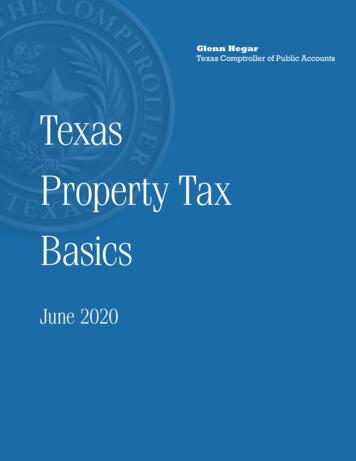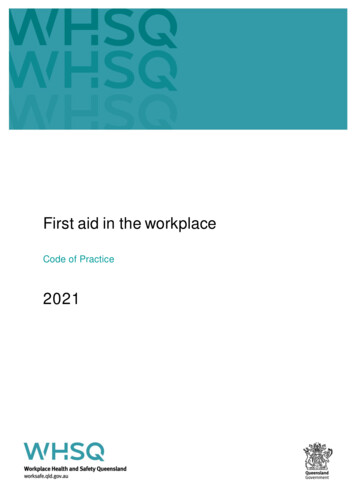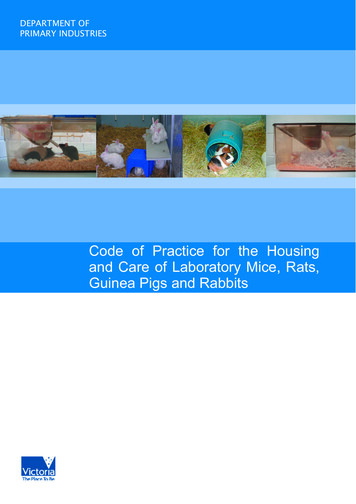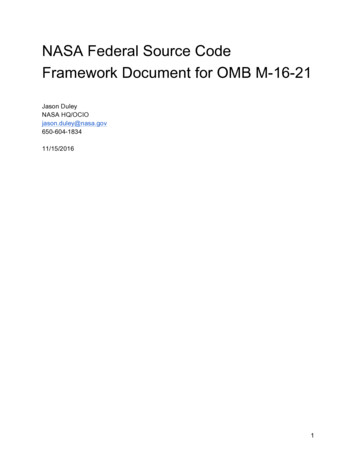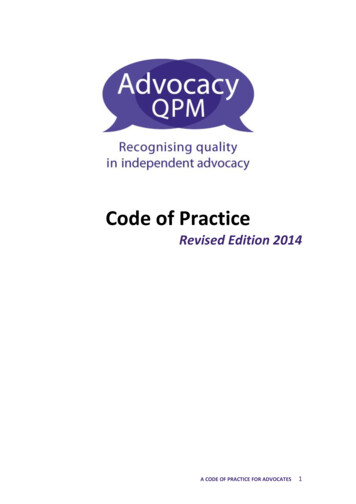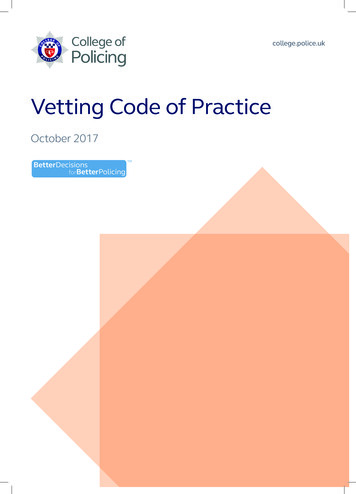
Transcription
college.police.ukVetting Code of PracticeOctober 2017ªBetterDecisionsforBetterPolicing
Vetting Code of PracticePresented to Parliament pursuant to Section 39A(5) of the Police Act 1996,as amended by Section 124 of the Anti-social Behaviour, Crime and Policing Act 2014October 2017
College of Policing Limited (2017)All content (excluding logos and photographs) is licensed under the termsof the Non-Commercial College Licence v1.1 except where otherwisestated. To view this licence visit http://www.college.police.uk/Legal/Documents/Non Commercial College Licence.pdfWhere we have identified any third party copyright information you willneed to obtain permission from the copyright holders concerned.This publication is available at www.gov.uk/government/publicationsAny enquiries regarding this publication should be sent to us atcontactus@college.pnn.police.ukISBN 978-1-5286-0055-2Printed on paper containing 75% recycled fibre content minimum.Printed in the UK by the APS Group on behalf of the Controller ofHerMajesty’s Stationery Office.CCS1017140102 10/17
College of PolicingContents1 Introduction072 Purpose083 Scope094 Statutory basis for the Code115 Transparency and accountability126 Decision-making in vetting15Vetting Code of Practice5
College of Policing6Vetting Code of Practice
College of Policing1Introduction1.1Everyone in the police service, and leaders in particular, must maintain high ethicaland professional standards and act with the utmost integrity. This is crucial inensuring public confidence in the service is maintained.1.2It is essential that the public is confident that police vetting processes are effectivein identifying those who pose a potential risk to others or who are otherwiseunsuitable for working within the police service.1.3Vetting is an integral part of a police force’s framework of ethics and professionalstandards. It assists with identifying individuals who are unsuitable to workwithin the police service, or to have access to police assets. This includes peoplewho are unsuitable through criminal activity or association, those who have ademonstrable lack of honesty or whose previous behaviour has been inconsistentwith the Code of Ethics, and those who are financially vulnerable.1.4Contracts for outsourcing police services and related areas are often of high value.Therefore, when dealing with procurement processes, the police service must beable to minimise the threat of its personnel being induced, through monetaryreward or other gratuity or favour, to reveal commercially sensitive information orunduly favouring one supplier over another. Effective vetting, and aftercare whereappropriate, is a critical measure required to mitigate these very real risks.1.5A thorough and effective vetting regime is a key component in assessing aperson’s integrity.Vetting Code of Practice7
College of Policing2Purpose2.1The Vetting Code of Practice sets out the vetting standards which are to beapplied by police forces in England and Wales.2.2This Code has been developed to help achieve, implement and maintain minimumnational standards and ensure those standards are consistently applied acrossthe police service.8Vetting Code of Practice
College of Policing3Scope3.1This Code of Practice replaces all guidance previously issued in relation topolice vetting.3.2The Code applies to all those engaged on a permanent, temporary, full-time,part-time, casual, consultancy, contracted or voluntary basis with the police, aswell as any individuals who apply to join the service. It also applies to those inpartner agencies who have unrestricted access to any police premises or policeinformation that is not publically available.3.3The purpose of the Vetting Code of Practice is to: support the overarching Code of Ethics support the Standards of Professional Behaviour set out the basic key principles of vetting in the police service set out the manner these principles are to be implemented in thepolice service ensure the consistent application of vetting standards across thepolice service.3.4The Code will be supported by Authorised Professional Practice (APP) onVetting which will describe the technical processes and detail needed toimplement vetting.3.5The Vetting Code of Practice applies to: all police forces in England and Wales vetting units outside the above which conduct police vetting the College of Policing and its personnel applicants to the police serviceVetting Code of Practice9
College of Policing individuals appointed to or employed by police forces, ie, police officers,members of police staff and members of the Special Constabulary(‘police personnel’) individuals and organisations working under contract to, in partnershipwith or on a voluntary basis with police forces in England and Wales the staff of local policing bodies who have unrestricted access to anypolice premises or police information that is not publically available.The term ‘local policing bodies’ refers to the offices of the 41 police and crimecommissioners, the Mayor’s Office for Policing and Crime in London, and theCourt of Common Council in the City of London.Although the Code of Practice applies to the offices of police and crimecommissioners, commissioners and their statutory deputies do not, by law,have to be vetted.3.6Everyone involved in policing has a personal responsibility to ensure theycomply with vetting requirements and that they report any material changein circumstances as soon as practicable.3.7Although vetting will help to identify many risks, it cannot identify all threatsand vulnerabilities. For example, force vetting cannot consider any vulnerabilityrelating to medical issues such as mental health.3.8Vetting will not be effective if used in isolation. It must form part of a widerprotective security regime.10Vetting Code of Practice
College of Policing4Statutory basis for the Code4.1The Vetting Code of Practice has been established by the College of Policingon behalf of the police service of England and Wales.4.2The Code applies directly to the police forces maintained for the police areas ofEngland and Wales defined in section 1 of the Police Act 1996. It is available foradoption by other police forces or agencies.Vetting Code of Practice 11
College of Policing5Transparency andaccountabilityPrinciplesThe following principles should underpin all decision-making within vetting:Principle 1In applying vetting, practitioners will comply with the requirements of thisCode and the Code of Ethics. Each case must be treated on its own merits.Principle 2Everyone working in a police environment will be vetted to the requisite level.This includes those who: have unrestricted or unsupervised access to police information, assetsor estates have access to force or national police systems, be that directly or remotely act as a representative of the police service have the power to make or significantly influence strategic decisionsin the police service, and includes members of partner agencies.Principle 3The level of vetting required for a person, for both force vetting and nationalsecurity vetting (NSV), will be proportionate to the role they carry out. Those whohold chief officer roles must, however, be vetted to Management Vetting (MV)and Security Check (SC) standard or above. Prospective chief officers must becleared to this level prior to attending a chief officer assessment process. Due tothe nature of their role, all chief constables (and equivalents) and deputy chiefconstables must be cleared to developed vetting (DV) standard.Principle 4Police vetting should comply with the standards laid out in APP on Vetting.12Vetting Code of Practice
College of PolicingPrinciple 5All vetting information must be stored in a suitably secure manner. The informationmust be treated confidentially and accessed by only those who have a clearlyidentified, justified business need.Principle 6Decision-making in respect of vetting clearance should be separate from,and independent of, recruitment and other human resources processes. Thereshould be an effective working relationship between vetting and professionalstandards departments.Principle 7Vetting clearance may be transferrable between posts and forces upon thecompletion of a vetting health check.Principle 8Chief constables, or their equivalents in other agencies, are responsiblefor ensuring that effective vetting arrangements are in place in their ownorganisations. In the case of collaborative arrangements, there must be a clearagreement as to who is responsible for ensuring each person is suitably vetted.Principle 9Decisions about vetting status should follow the national decision model (NDM)and must be accurately recorded. The presumption is that the rationale for anyrejection should be communicated to the applicant in as much detail as possible.There are occasions where it is not possible to provide a detailed rationale, butwhere this is the case, the justification must be documented and be auditable.Principle 10Where a person is subject to a vetting rejection they should have a right of appealto a person independent of the original decision-maker. The outcome of an appealshould be communicated to the applicant in as much detail as possible.Vetting Code of Practice 13
College of PolicingPrinciple 11All police personnel should be subject to periodic re-vetting in accordancewith APP on Vetting.Principle 12Public confidence may be affected if an officer has a previous conviction orcaution, therefore there is a rebuttable presumption that a person will notbe suitable for appointment as a police officer or special constable if they havea previous conviction or caution for a criminal offence, especially if it relates todishonest or corrupt practices, or violence. Factors that may weigh against thispresumption being applied in individual cases include the nature and severityof the offence, the person’s age at the time they committed the offence,and the length of time since the offence was committed. Each case must beconsidered on its own merits including both the individual’s role in the offenceand the nature of the conviction or caution. The same presumption applies topolice staff roles with designated powers or roles where there is a likelihoodof being in the evidential chain.Applications for a position as a police officer; a special constable; or as a memberof police staff where that member of staff may be in the evidential chain are tobe rejected in all cases where: offences were committed as an adult or juvenile which resulted in aprison sentence (including custodial, suspended or deferred sentenceand sentences served at a young offenders’ institution or communityhome); or the applicant is a registered sex offender or is subject to a registrationrequirement in respect of any other conviction.14Vetting Code of Practice
College of Policing6Decision-making in vetting6.1Vetting clearance decisions must only be made at the appropriate level, usuallythe force vetting officer (FVO) or an identified or nominated vetting decision-maker.6.2The vetting decision must be made on a case-by-case basis, taking intoconsideration all relevant matters.6.3Where vetting clearance is declined, or granted following assessment ofinformation revealed during the vetting process, the decision-maker mustrecord the full rationale for the decision on the vetting file.6.4In making the vetting decision, the decision-maker should refer to the NDM:National Decision ModelTake actionand review whathappenedIdentify optionsand contingenciesGatherinformation andintelligenceCode ofEthics –Values andProfessionalStandardsAssess threat and riskand develop a workingstrategyConsider powersand policyVetting Code of Practice 15
College of Policing6.5Vetting decision-makers must take account of the requirements ofChapter 18 of the Crown Prosecution Service (CPS) Disclosure Manual,which deals with revealing and disclosing relevant matters during judicialproceedings. Where forces find that a person cannot be relied on to actas a witness of truth in court proceedings, they should not grant vettingclearance for appointment to a post where the role would require thatperson to provide evidence at court.6.6Forces should monitor the application of the Vetting Code andAPP on Vetting to identify whether there is any disproportionalityin decision-making, for example in respect of black and minorityethnic (BME) groups. If disproportionality is identified the reasonsfor this should be clearly understood and, where appropriate,suitable action taken to address it.16Vetting Code of Practice
College of PolicingVetting Code of Practice 17
About the CollegeWe’re the professional body for everyonewho works for the police service in Englandand Wales. Our purpose is to provide thoseworking in policing with the skills andknowledge necessary to prevent crime,protect the public and secure public trust.college.police.ukFollow 53I1017
College of Policing Vetting Code of Practice 11 4 Statutory basis for the Code 4.1 The Vetting Code of Practice has been established by the College of Policing on behalf of the police service of England and Wales. 4.2 The Code applies directly to the police forces maintained for the police areas of England and Wales dei section 1 of the Police .





